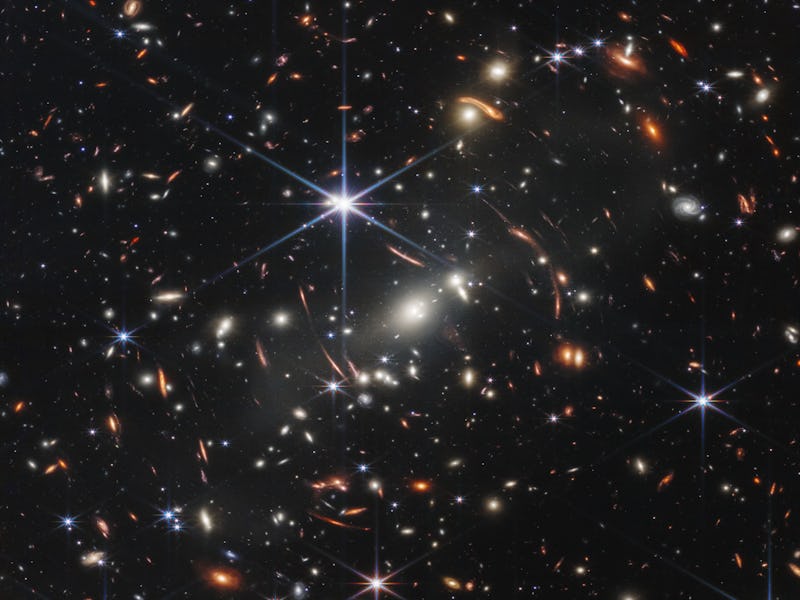It Turns Out Tiny Galaxies Made the Universe Visible
Dwarf galaxies packed a surprisingly energetic punch in the early universe — and gave us all a helluva view.

A few hundred million years after the Big Bang, a thick fog of hydrogen gas shrouded the newborn universe in darkness. Stars had begun to form in the densest clumps, but the surrounding gas muffled their light. According to a new study, the radiation that eventually cleared that dense fog – and made space see-through – came from lots of tiny, unassuming dwarf galaxies. Sorbonne University astrophysicist Hakim Atek and his colleagues published their work in the journal Nature.
In images like this one, JWST’s powerful infrared instruments capture light from some of the oldest and faintest galaxies in the universe.
Clearing the Cosmic Fog
Atek and his colleagues used JWST and the Hubble Space Telescope to study eight of the faintest, oldest galaxies in the universe. These tiny galaxies are visible, even to JWST’s sensitive instruments, only because their light was magnified by the spacetime-warping gravity of a massive galaxy cluster that lies between them and Earth. Each of these galaxies contains just a few billion stars – somewhere between a hundredth and a tenth the population of our Milky Way – but Atek and his colleagues caught them pumping out a surprising amount of high-energy radiation into the universe.
“The surprise is that these small galaxies produce much more ionizing radiation that what we expected,” Atek tells Inverse – about four times as much, in fact. Ionizing radiation is usually shorter-wavelength radiation like gamma rays and X-rays, which carries enough energy to strip electrons from atoms, turning them into electrically-charged ions. That process is what turned the opaque hydrogen gas that suffused the early universe into transparent electrically-charged plasma.
Physicists have a pretty clear idea of how that process, called the Epoch of Reionization, played out: radiation stripped away electrons from the hydrogen gas that filled the ancient universe, turning it into plasma that light could pass through. The cosmic fog cleared away in patches and bubbles, eventually leaving behind only wisps in an otherwise transparent universe. But until recently, they’ve debated whether all that ionizing radiation came from just a few huge, bright galaxies with actively-feeding supermassive black holes at their centers.
“This is the first evidence that very faint and tiny galaxies are the main drivers of reionization,” says Atek.
It turns out that our see-through universe may have been the work of bunches of tiny galaxies, each home to massive young stars. Individually, none of these galaxies is terribly impressive compared to the much rarer large galaxies that sparsely dot early space. But together, Atek and his colleagues say they may have burned brightly enough to end the Cosmic Dark Ages.
Atek and his colleagues measured the amount of ionizing radiation emitted from each of the eight distant dwarf galaxies in their sample. That high-energy radiation had been softened and stretched into infrared light on its journey across the expanding universe, but the physicists were able to calculate what its original energy would have been – and the answer was more than enough to ionize the hydrogen gas that hid the universe from itself for millions of years.
“The source of this ionizing radiation is clearly newborn massive stars, a few million years old,” says Atek.
The Search For The Smallest Galaxy
Science, if it’s done right, involves a lot of double-checking and triple-checking, and Atek and his colleagues say that’s the next step in understanding how the cosmic fog cleared. They want to study other groups of very old, very faint, very small galaxies, located in different patches of sky, to make sure their sample wasn’t just unusually energetic.
Atek says his team plans to use JWST and the gravitational lens of another nearby galaxy cluster to study an even fainter group of galaxies, dating back to the formation of the universe’s very first stars. They hope to answer more questions, not just about reionization but about how galaxies form and grow.
“One of the science goals we are pursuing now is to identify the smallest galaxies that can form in the Universe,” says Atek. “Our models predict that if the galaxy is too small it cannot form stars anymore. This will help us understand how the first galaxies formed.”